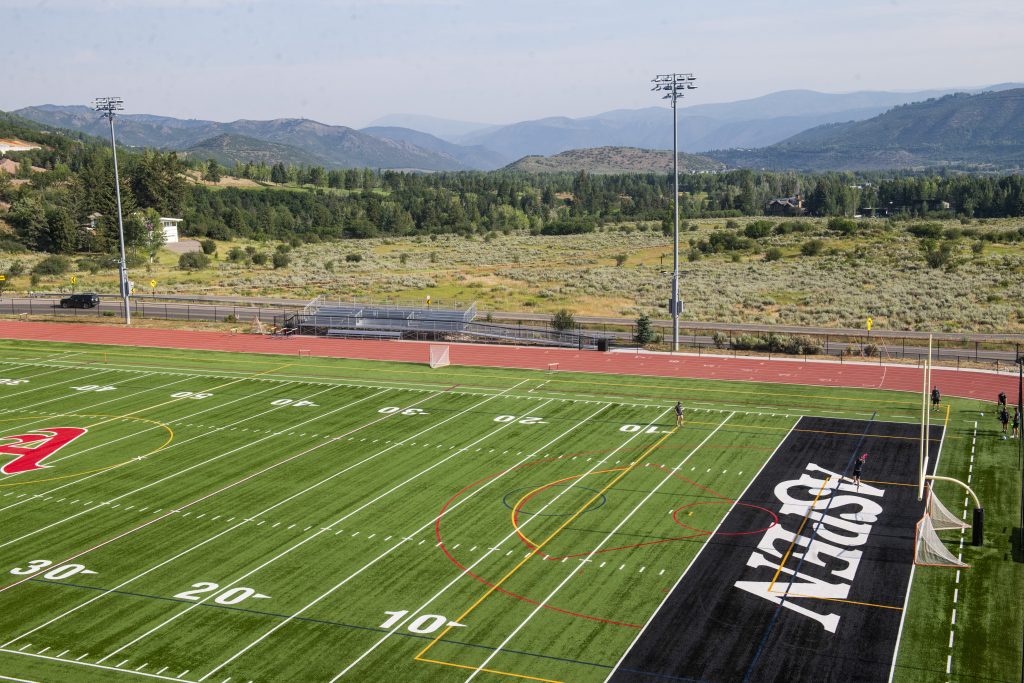Aspen schools look underground for sustainable energy
District gets two grants to explore a potential geothermal well field, some hope for an even-deeper dive

Kelsey Brunner/Aspen Journalism
In a town best known for snow and its mountain backdrops, Joe Waneka has what might seem an odd problem to solve. As director of operations for the Aspen School District, he is tasked, in part, with keeping the 1,600 students enrolled in the district’s elementary, middle, and high schools cool enough so that heat does not preclude learning.
That has become more of an issue on the 32-acre campus set amid the rolling terrain where Maroon Creek hurries toward the valley floor. Part of the reason is Colorado’s mid-August return to schools. Summers have been warming, too. And then there is the smoke from wildfires.
Since students returned to classes, temperatures on the hottest days have reached 78 degrees inside the buildings. “That is their tipping point, if you will, when they start thinking more about getting comfortable than teaching or learning,” he said. “By 80 degrees, you are overwhelmed.”
Open the windows at night and let in some fresh mountain air? It helps until past noon. It does not help at all if wildfires have made the air unhealthy. On Aug. 14, the second day of school this year, the district announced it was making KN95 masks available to all who wanted them after nearby wildfires turned local skies hazy.
The middle school has central air conditioning. The elementary and high schools have 68 portable air-conditioning wall units, all of them noisy and cumbersome. Waneka describes them as Band-Aids. A better solution is needed.
In November, Waneka began investigating potential remedies. Conventional chiller units could be added but would add an extra $100,000 to $125,000 per building in electricity costs.
By March, Waneka had narrowed his focus to geothermal, to tap the underground for both coolness and heat. This would comport with the school district’s strategic plan, which calls for students and staff to have access to “sustainable energy.”
Burning natural gas at the three schools and two associated buildings and the use of snowmelt systems produce 235,000 therms of energy heat annually, according to a report by The GreyEdge Group, a Utah-based consultant that specializes in geothermal energy networks. Greenhouse gas emissions produced are comparable to burning almost seven railcars of coal, according to an Environmental Protection Agency calculator.
Two grants have assisted the school district in exploring the feasibility of creating a well field and retrofitting the buildings. In June, the Colorado Energy Office announced a grant of $78,400, one of five dozen geothermal grants distributed across Colorado in a $12 million program approved by state legislators in 2023. More recently, the Community Office for Resource Efficiency awarded the district a $50,000 grant.
Even before receiving the grants, the school district hired The GreyEdge Group to evaluate a geothermal ambient temperature loop. The report delivered by the company in June estimated that a loop system could reduce annual heating-related emissions 92%.
A test bore may yet be drilled this fall. The drilling would take three days. Cost is estimated at roughly $75,000. Three potential locations on the campus have been established. Test bores — a requirement of the state grant — provide information about soil composition and underground thermal characteristics. This informs decisions about design of the full well field. Scores of closely spaced wells would probably be needed.
If successful, this thermal energy network would provide heat and cooling for up to 600,000 square feet. That includes the schools and other buildings, along with 30,000 square feet of future buildings and 157,000 square feet of athletic fields and the track.
This technology has been deployed with great success elsewhere in Colorado and other states, and many more systems are planned.
Three miles from the schools, two test bores have already been drilled for what is being called Aspen Airport Business Center Thermal Energy Network. Aided by a $250,000 grant from the Colorado Energy Office, Pitkin County is exploring how to integrate a microgrid with a heating district to reduce energy loads at the airport as well as the Pitkin County Public Works and Roaring Fork Transportation Authority facilities.
At his office in the basement of Aspen High School, Waneka said he was not content to go with easier off-the-shelf solutions to the cooling needs at the schools. Exploring options might produce a truly sustainable energy system and reduce fuel costs. “To me, it is foolish not to explore,” he said.
A mature technology
Geothermal systems exploit the relatively constant temperatures found underground. Geo-exchange, one of several geothermal technologies, uses electric pumps to extract that heat or coolness as needed in the buildings. The process is similar to that used by refrigerators.
Many schools across Colorado already use geo-exchange technology, as does the governor’s mansion in Denver and the state Capitol.
The Poudre School District first used geo-exchange in 2002 at an operations building in Fort Collins. It used the same technology in a school in 2004 and again recently at three new schools in Loveland, in Timnath, and in Wellington.
Grand Junction has Colorado’s most prominent use of geothermal. Officials at Colorado Mesa University in 2008 pulled the trigger on a geo-exchange system that now provides heating and cooling for 1.2 million square feet of space contained within 16 campus buildings. The success has drawn national attention.
University officials say the geo-exchange pipes under soccer fields and other open spaces on the campus coupled with other cost-savings measures and efficiencies enable them to save $1.5 million annually in utility costs. This, they say, allows Colorado Mesa to charge the third-lowest combined tuition and fee rate among Colorado’s 12 public colleges and universities.
A thermal energy network connects multiple buildings through a common geo-exchange system. Pagosa Springs has had such a system for 33 customers in its downtown buildings since 1982. Of course, it has hot springs nearby.
No need for hot springs, though. Ground temperatures everywhere rise the lower you go. In Colorado, wells for geo-exchange most commonly are sunk 300 to 500 feet.
Standard geo-exchange systems rely solely on pushing heat into and pulling heat from Earth as needed. The energy between the ground and the surface is transferred via recycling water.
At the campus, something more complex than a simple push-and-pull of underground energy from the underground is being investigated. Aspen’s climate is part of the story.
Winters in Aspen, at 8,000 feet, last longer and more heat is commonly needed than in Denver or Grand Junction. Given these longer winters and greater heating needs, might a potential thermal energy network on the Aspen schools campus also draw energy from other sources in the area?
For example, can exhaust heat produced in making ice at the nearby Aspen Recreation Center be sequestered in the geothermal well field? Similarly, a sewer pipeline runs relatively proximate to the schools campus. Might the heat be extracted for use in the campus network? GreyEdge examined various alternatives in its June report.
These ideas are not novel. For example, in Denver, heat is drawn from a 72-inch pipeline that transports sewage from downtown to a treatment plant. The extracted heat provides 90% of what is needed for buildings on the 250-acre campus of the National Western Complex, site of the annual stock show.
In Vail, the town government has been working on a smaller-scale application of the same concept, using heat from sewage to melt snow at Lionshead Village, which sits at the base of Vail Mountain.
Holy Cross Energy, the electrical provider for Vail and parts of Aspen, including the schools campus, hopes to see thermal energy networks succeed. It expects to deliver 80% emissions free electricity in 2025. For 2030, it has a goal of 100%.
To achieve that ambitious goal, it needs to figure out ways to lower peak demand and improve overall efficiency. The utility sees geothermal energy networks as part of that strategy.
“At times of oversupply, the excess electricity would power a boiler or a chiller, raising or lowering the water temperature in the thermal loop,” Holy Cross Energy CEO Bryan Hannegan wrote in an email.
“This reduces the need for electricity use later by the building’s heat pump,” Hannegan added. “The net effect is to consume excess electricity, store it, and then use it to reduce future electricity demand — basically a thermal version of battery storage. This helps us match our electricity demand to our electricity supply in a more cost-effective way.”
Lauren Suhrbier, who is with Carbondale-based Clean Energy Economy for the Region (CLEER), describes the work at the schools campus as being in an early stage of investigation. CLEER, which has been developing expertise in geothermal since 2023, has taken on the role of project manager for the Aspen schools’ geothermal exploration and has been paid $10,000 by the school district as of mid-August.
Suhrbier said the district hopes the geo-exchange network can be accomplished for less than $20 million. One possibility is to transfer the risk to an outside financier through an energy performance contract. There is a high probability that this could be part of a future bond election, said Waneka.
A bigger, deeper idea
Another idea involving the campus has even more ambition. This idea — presented to the school district by GreyEdge — would be to drill deep to create a reservoir of energy thousands of feet below the surface and under an impervious layer of rock. Energy in the form of pressure could be stored and then tapped to produce electricity.
Long-duration storage will be crucial for the decarbonization of electricity by all electrical utilities. Existing battery technologies come up short. Pumped-storage hydro, an old technology, has been used near Georgetown and in reservoirs near Leadville for decades. Water from a higher reservoir is released as needed to produce electricity then pumped back to the upper reservoir when electricity is plentiful. Several more such pumped-storage ideas are being pursued along the Yampa River west of Steamboat Springs.
GreyEdge has partnered with two other companies — Pure-Green Colorado and Sage Geosystems — to propose a 8,000- to 10,000-foot well at the Aspen campus. Excess renewable energy could be stored in that underground reservoir.
This reservoir might be compared to a balloon. The rock at that depth would be fractured to create a place where energy can be stored under pressure. Just as air is exhaled into a balloon and then released, energy could be stored in this underground balloon then released to generate electricity.
GreyEdge estimates a potential capacity for 5 megawatts of generation. That’s about the same capacity as the 35-acre solar farm that opened in 2021 near Woody Creek. The difference is that the solar farm produces electricity only when the sun is shining. The underground reservoir would produce electricity at crucial times as well as provide heat as needed for the school district campus.
Drilling deep holes is a surmountable challenge, as oil and gas drillers in the Piceance Basin, north of Rifle, have routinely drilled wells 8,000 to 10,000 feet deep.
But does a geologic lid exist to prevent energy from escaping that “balloon”? GreyEdge has assembled geological reports that suggest that such a lid exists in the area of the Aspen campus.
GreyEdge believes that this idea of underground storage has been deployed only in Iceland.
The idea was delivered to the Aspen School District, but no formal discussion has been held nor commitments made. It is, at this point, just an idea.
Cost matters
Cost matters everywhere. In new buildings, the greater cost of geothermal as compared to conventional heating and cooling is negligible, according to study for a new public building in Fort Collins.
Retrofitting buildings, however, always costs more. The question is how much in utility bills projects recoup and how quickly. In Fort Collins, utility costs for that first school building with geothermal declined 50% in the first decade. However, Aaron Tilden, of Millig Design Build, said that retrofits commonly need grants to pencil out in less than a 20- to 25-year time frame.
Grants were crucial to the decision by school board members at Liberty School District J-4, which has 78 students and is located amid farms and ranches 130 miles east of Denver. The school board members were aware that the geo-exchange system would reduce emissions, but that was not the motivation.
In Fort Collins, though, Poudre School District has energy goals of being good community stewards and protective of natural resources while being fiscally prudent. “The two go hand in hand,” Trudy Trimbath, the district’s energy and sustainability manager, said of the geo-exchange systems.
Eagle County needed to replace a natural gas system but also has a goal of setting an example with its $14.5 million geo-exchange system now being installed at the county courthouse campus in Eagle. The network of 66 wells will provide heat and cooling for 75,657 square feet for three buildings beginning in October.
County officials say they can justify the expense not only in cost savings over time but in the external costs. Eagle County Commissioner Matt Scherr said the existing natural-gas-burning system needed to be replaced but part of the calculation was recognition of the need to reduce greenhouse gases.
As for the Aspen School District, results of the test bore will inform whether any ideas around geothermal become a formal proposal. If the results are favorable, it’s possible that a project could get underway in 2027.
Allen Best publishes energy and water transitions stories at BigPivots.com. This story was written in consultation with Aspen Journalism. Aspen Journalism is a nonprofit, investigative news organization covering water, environment, social justice and more. Visit http://aspenjournalism.org.
Aspen’s Mactoberfest returns
The free annual event will be back for its third year 1 to 3 p.m. Saturday, Sept. 6, on the 300 Block of East Hopkins Ave. Local restaurants will compete with signature Macaroni and Cheese dishes that will be voted on by attendees. This year, two winners will be crowned with the Judges’ Favorite award and the Crowd Favorite award.
Most expensive house for sale in America hits Aspen market
The most expensive house for sale in the country hit the housing market in Aspen last week, a 74.1 acre property listed at $300,000,000.









